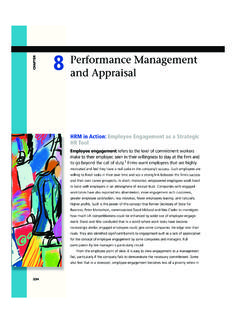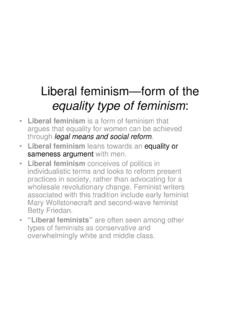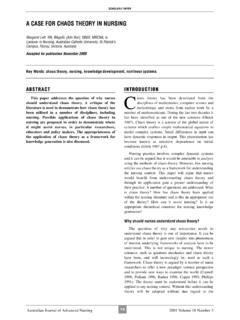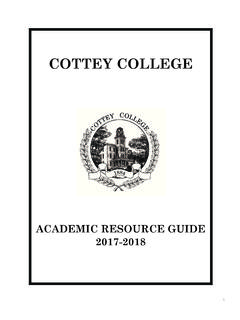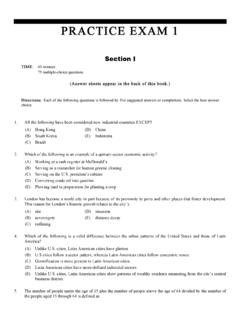Transcription of THE SOCIOLOGY CHAPTER 1 OF GENDER Theoretical …
1 Events during the first decade of the millinnium have profoundly affected GENDER study of GENDER emerged as one of the most important trends in the disciplineof SOCIOLOGY in the twentieth century. The research and theory associated withstudying GENDER issues propelled the SOCIOLOGY of GENDER from the margins tobecome a central feature of the discipline. To understand the powerful socialeffects of the Millennium Recession(MR) and patterns of globalization, for example,sociological analysis must account for GENDER . This text documents how sociologistshave aided our understanding of the influence of GENDER in shaping our lives, ourattitudes, and our behavior. This understanding is enhanced by investigating thelinks between SOCIOLOGY and other disciplines and by integrating key concepts suchas race, social class, and sexuality to clarify GENDER relations.
2 SOCIOLOGY is interestedin how human behavior is shaped by group life. Although all group life is orderedin a variety of ways, GENDER is a key component of the ordering. An explosion ofCHAPTER 1 THE SOCIOLOGY OF GENDERT heoretical Perspectives and Feminist FrameworksBASIC SOCIOLOGICAL CONCEPTSKey Concepts for the SOCIOLOGY of GenderDistinguishing Sex and GenderSOCIOLOGICAL PERSPECTIVES ON GENDER ROLESF unctionalismConflict TheorySymbolic InteractionFeminist Sociological TheoryFEMINISM AND ITS BRANCHESL iberal FeminismSocialist FeminismRadical FeminismMulticultural and Global FeminismEcofeminismFEMINISM AND THE MEDIAP ortrayals of FeminismFeminism and Election 2008 Challenging the Backlash to FeminismAll causes, social and natural, combine tomake it unlikely that women should becollectively rebellious to the power ofmen.
3 They are so far in a position different from all other subject classes,that their masters require something more from them than actual service. Men do not want solely the obedience of women, they want their sentiments. John Stuart Mill, The Subjection ofWomen(1869)12 The SOCIOLOGY of GENDER : Theoretical Perspectives and Feminist Frameworksresearch on GENDER issues now suggests that all social interactions, and the institu-tions in which the interactions occur, are gendered in some manner. Accountingfor this gendering has reshaped the Theoretical and empirical foundations of soci-ology. On the Theoretical side, GENDER awareness has modified existing sociologicaltheory and led to the creation of a new feminist paradigm. On the empirical side, GENDER awareness has led to innovative research strategies and opened up newtopics for sociological inquiry.
4 We open with an examination of basic concepts andtheories that lay the groundwork for our sociological journey into GENDER SOCIOLOGICAL CONCEPTSAll societies are structured around relatively stable patterns that establish howsocial interaction will be carried out. One of the most important social structuresthat organizes social interaction is status a category or position a personoccupies that is a significant determinant of how she or he will be defined andtreated. We acquire statuses by achievement, through our own efforts, or byascription, being born into them or attaining them involuntarily at some otherpoint in the life cycle. We occupy a number of statuses simultaneously, referredto as a status set, such as mother, daughter, attorney, patient, employee, andpassenger.
5 Compared to achieved statuses occurring later in life, ascribedstatuses are those immediately impacting virtually every aspect of our lives. Themost important ascribed statuses are GENDER , race, and social class. Since a statusis simply a position within a social system, it should not be confused with rank orprestige. There are high-prestige statuses as well as low-prestige statuses. In theUnited States, for example, a physician occupies a status ranked higher inprestige than a secretary. All societies categorize members by status andthen rank these statuses in some fashion, thereby creating a system of social strat-ification. People whose status sets are comprised of low-ranked ascribed statusesmore than high-ranked achieved statuses are near the bottom of the social strati-fication system and vulnerable to social stigma, prejudice, and discrimination.
6 Todate, there is no known society in which the status of female is consistentlyranked higher than that of roleis the expected behavior associated with a status. Roles areperformed according to social norms, shared rules that guide people s behaviorin specific situations. Social norms determine the privileges and responsibilitiesa status possesses. Females and males, mothers and fathers, and daughters andsons are all statuses with different normative role requirements attached tothem. The status of mother calls for expected roles involving love, nurturing,self-sacrifice, home-making, and availability. The status of father calls forexpected roles of breadwinner, disciplinarian, home technology expert, and ulti-mate decision maker in the household.
7 Society allows for a degree of flexibilityin acting out roles, but in times of rapid social change, acceptable role limits areoften in a state of flux, producing uncertainty about what appropriate rolebehavior should be. People may experience anomie normlessness becausetraditional norms have changed but new ones have yet to be developed. Forexample, the most important twentieth-century trend impacting GENDER roles inthe United Sates is the massive increase of women in the labor force. Althoughwomen from all demographic categories contributed to these numbers, motherswith preschool children led the trek from unpaid home-based roles to full-timepaid employment roles. In acting out the roles of mother and employee, womenThe SOCIOLOGY of GENDER : Theoretical Perspectives and Feminist Frameworks3are expected to be available at given times to satisfy the needs of family and work-place.
8 Because workplaces and other social institutions have not been modifiedin meaningful ways to account for the new statuses women occupy, their rangeof acceptable role behavior is severely restricted. As a result, family and work-place roles inevitably collide and compete with one another for the mother -employee s time and Concepts for the SOCIOLOGY of GenderAs key components of social structure, statuses and roles allow us to organizeour lives in consistent, predictable ways. In combination with established norms,they prescribe our behavior and ease interaction with people who occupy differentsocial statuses, whether we know these people or not. There is an insidious side tothis kind of predictable world. When normative role behavior becomes too rigidlydefined, our freedom of action is often compromised.
9 These rigid definitions areassociated with the development of stereotypes oversimplified conceptions thatpeople who occupy the same status group share certain traits in common. Althoughstereotypes can include positive traits, they most often consist of negative ones thatare then used to justify discrimination against members of a given group. Thestatuses of male and female are often stereotyped according to the traits they areassumed to possess by virtue of their biological makeup. Women are stereotyped asflighty and unreliable because they possess uncontrollable raging hormones thatfuel unpredictable emotional outbursts. The assignment of negative stereotypes canresult in sexism, the belief that the status of female is inferior to the status of are not immune to the negative consequences of sexism, but females are morelikely to experience it because the status sets they occupy are more stigmatized thanthose occupied by males.
10 Compared to males, for example, females are more likelyto occupy statuses inside and outside their homes that are associated with less power,less prestige, and less pay or no pay. Beliefs about inferiority due to biology are rein-forced and then used to justify discrimination directed toward is perpetuated by systems of patriarchy, male-dominated social struc-tures leading to the oppression of women. Patriarchy, by definition, exhibitsandrocentrism male-centered norms operating throughout all social institu-tions that become the standard to which all persons adhere. Sexism is reinforcedwhen patriarchy and androcentrism combine to perpetuate beliefs that genderroles are biologically determined and therefore unalterable. For example,throughout the developing world beliefs about a woman s biological unsuitabilityfor other than domestic roles have restricted opportunities for education andachieving literacy.


